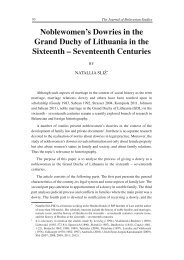Reviews - The Journal of Belarusian Studies
Reviews - The Journal of Belarusian Studies
Reviews - The Journal of Belarusian Studies
Create successful ePaper yourself
Turn your PDF publications into a flip-book with our unique Google optimized e-Paper software.
REVIEWS 355<br />
vocabulary and Ściapan Majchrovič's<br />
rather tendentious monograph (V.<br />
Dunin-Marcinkievič, Minsk, 1955)<br />
make Dunin-Marcinkievič the most<br />
thoroughly studied <strong>of</strong> all the Byelorussian<br />
writers <strong>of</strong> the nineteenth<br />
century.<br />
Tvorčaje pabracimstva is one <strong>of</strong> the<br />
best books on modern Byelorussian<br />
literature to have appeared for a very<br />
long time and bodes well for the<br />
future <strong>of</strong> this neglected subject.<br />
A. B. McM.<br />
BIEŁARUSKAJA PADSAVIECKAJA LITARATURA PIERŠAJ PAŁAVINY<br />
60-YCH HADOŬ. Stanisłaŭ Stankievič. Biełaruski Instytut Navuki i<br />
Mastactva, New York — Munich, 1967. 169 pages.<br />
Extremely valuable as a full and<br />
detailed description <strong>of</strong> the prose, plays<br />
and poetry <strong>of</strong> a multitude <strong>of</strong> contemporary<br />
writers, this book, unfortunately,<br />
bears out the implications<br />
<strong>of</strong> its title and reveals deliberate<br />
tendentiousness in its selection and<br />
quotation <strong>of</strong> examples. For an<br />
example see pp. 133-4 where the<br />
meaning <strong>of</strong> a passage from Barys<br />
Sačanka's Ziamla prodkaŭ is materially<br />
altered by the deliberate omission<br />
<strong>of</strong> lines apparently distasteful to the<br />
author. This is no less to be condemned<br />
than the distortion <strong>of</strong> facts<br />
in order to accord with some inflexible<br />
<strong>of</strong>ficial line <strong>of</strong> policy; indeed,<br />
it is even more reprehensible, for this<br />
author is without the excuse <strong>of</strong> hidden<br />
persuasion. Also disturbing to the<br />
serious student are the orthographical<br />
changes Stankievič permits himself to<br />
make in order that the quotations may<br />
conform to the language <strong>of</strong> the<br />
commentary; this is particularly unfortunate<br />
here, in view <strong>of</strong> the fact<br />
that the language used by the author<br />
is far from the literary norm in both<br />
spelling and vocabulary. In spite <strong>of</strong><br />
this, however, the book does represent<br />
a considerable body <strong>of</strong> detailed research<br />
and is easily the fullest<br />
bibliographical review <strong>of</strong> contemporary<br />
Byelorussian literature available<br />
at the present time.<br />
A. B. McM.<br />
BIEŁARUSKAJA NARODNAJA VUSNA-PAETYČNAJA TVORČAŚĆ (Byelorussian<br />
Oral Folk-poetry). Ed. P. Hlebka, I. Hutaraŭ and M. Hrynbłat.<br />
Minsk, 1967. 392 pages.<br />
This is a collection <strong>of</strong> papers published<br />
by the Institute <strong>of</strong> Arts,<br />
Ethnography and Folklore <strong>of</strong> the<br />
Byelorussian Academy <strong>of</strong> Sciences,<br />
and deals with the history <strong>of</strong> Byelorussian<br />
folklore from the earliest<br />
times to the present day. It will come<br />
as no surprise to those familiar with<br />
works <strong>of</strong> this kind to find that more<br />
than half the book concerns material<br />
dating from the beginning <strong>of</strong> the<br />
present century.<br />
It is extremely difficult to deal<br />
objectively with Soviet publications<br />
on folklore, since general concepts <strong>of</strong><br />
what constitutes genuine folk traditions<br />
differ so widely from those<br />
which prevail in the Soviet Union.<br />
“Folklore”, writes Hutaraŭ, “is one <strong>of</strong><br />
the forms <strong>of</strong> working class social consciousness.<br />
It is an inalienable part <strong>of</strong><br />
its spiritual culture, a keen-edged<br />
weapon in the struggle for its social<br />
and national interests” (p. 7).<br />
On such a definition, it is possible<br />
to treat as folklore any party slogan,<br />
political jingle or doggerel verse with<br />
a social content, and to exclude<br />
genuinely popular spiritual hymnody<br />
or religious verse. If Hlebka and his<br />
collaborators have adopted a broad<br />
attitude to songs <strong>of</strong> social protest (at<br />
least from an age when protest was<br />
possible), and manufactured political<br />
poetry, they have also provided a few<br />
interesting but all too brief details <strong>of</strong><br />
popular carols and hymns. Some <strong>of</strong><br />
the political rhymes are <strong>of</strong> such a<br />
nature, that they can only be savoured<br />
in their original and pristine state,<br />
unadorned by comment:<br />
У касмічную ракету<br />
Чалавек савецкі сеў.<br />
Слава партыі, Саветам<br />
Мы спяваем шчыра ўсе.<br />
Не паклонімся мы богу,<br />
Зубы выб'ем сатане,<br />
I праклалі мы дарогу,<br />
Серп i молат на Луне.





